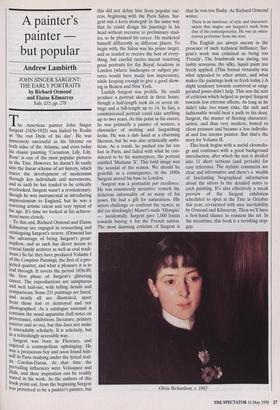A painter's painter but popular
Andrew Lambirth
JOHN SINGER SARGENT: THE EARLY PORTRAITS by Richard Ormond and Elaine Kilmurray Yale, £35, pp. 278 The American painter John Singer Sargent (1856-1925) was hailed by Rodin as 'the van Dyck of his day'. He was immensely successful in his lifetime on both sides of the Atlantic, and even today his classic painting 'Carnation, Lily, Lily, Rose' is one of the most popular pictures in the Tate. However, he doesn't fit easily into the linear scheme of art history, which traces the development of modernism through key individuals and movements, and as such he has tended to be critically overlooked. Sargent wasn't a revolutionary, though he was instrumental in introducing Impressionism to England, but he was a towering artistic talent and very typical of his age. It's time we looked at his achieve- ment more closely.
To this end, Richard Ormond and Elaine Kilmurray are engaged in researching and cataloguing Sargent's oeuvre. (Ormond has the advantage of being Sargent's great- nephew, and as such has direct access to crucial family archives as well as oral tradi- tions.) So far they have produced Volume I of the Complete Paintings, the first of a pro- jected quartet, and what a pleasure it is to leaf through. It covers the period 1856-89, the first phase of Sargent's glittering career. The reproductions are sumptuous and well laid-out, with telling details and Comparisons. Some 231 paintings are listed, and nearly all are illustrated, apart from those lost or destroyed and not photographed. As a catalogue raisonne it contains the usual apparatus (full notes on provenance, exhibitions, literature, primary Sources and so on), but this does not make it unreadably scholarly. It is scholarly, but in a refreshingly accessible way. Sargent was born in Florence, and enjoyed a cosmopolitan upbringing. He Was a precocious boy and soon found him- self in Paris studying under the lyrical real- ist Carolus-Duran. At that time the Prevailing influences were Velasquez and HaIs, and their inspiration can be readily traced in his work. As the authors of this book point out, from the beginning Sargent was perceived to be a painter's painter, but this did not debar him from popular suc- cess, beginning with the Paris Salon. Sar- gent was a keen strategist: in the same way that he could design his paintings in his head without recourse to preliminary stud- ies, so he planned his career. He marketed himself differently in different places. To begin with, the Salon was his prime target, and so tended to receive the best of every- thing, but careful tactics meant reserving good portraits for the Royal Academy in London (where landscapes or subject pic- tures would have made less impression), while keeping enough to give a good show- ing in Boston and New York.
Luckily Sargent was prolific. He could produce a portrait sketch in three hours, though a half-length took six or seven sit- tings and a full-length up to 14. In fact, a commissioned portrait could take anything up to two years. At this point in his career, he was primarily a painter of women, a chronicler of melting and languishing looks. He was a dab hand at a charming likeness, but he was also artistically ambi- tious. As a result, he pushed too far too fast in Paris, and failed with what he con- sidered to be his masterpiece, the portrait entitled 'Madame X'. This bold image was the scandal of the season. We should be grateful: as a consequence, in the 1880s Sargent moved his base to London. Sargent was a portraitist par excellence. He was consistently inventive: remark the delicious informality of so many of his poses. He had a gift for naturalness. His sitters challenge or confront the viewer, as did (so shockingly) Mallet's nude 'Olympia' — incidentally, Sargent gave 1,000 francs towards buying it for the French nation. The most damning criticism of Sargent is that he was too flashy. As Richard Ormond writes:
There is an insolence of style and characteri- sation that singles out Sargent's work from that of his contemporaries. He was an osten- tatious performer from the start.
The English are always uneasy in the presence of such technical brilliance; Sar- gent's work was criticised as being too `French'. The brushwork was daring, too lushly sensuous, the silky, liquid paint too freely applied. (This formal virtuosity was what appealed to other artists, and what makes the paintings look so fresh today.) A slight tendency towards contrived or exag- gerated poses didn't help. This was the sort of criticism which helped to propel Sargent towards less extreme effects. As long as he didn't take too many risks, the rich and fashionable would beat a path to his door. Sargent, the master of fleeting characteri- sation, and thus very modern, bowed to client pressure and became a less individu- al and less intense painter. But that's the story for Volume II.
This book begins with a useful chronolo- gy and continues with a good background introduction, after which the text is divided into 11 short sections (and periods) for easy reference. The stylistic comments are clear and informative and there's a wealth of fascinating biographical information about the sitters in the detailed notes to each painting. It's also effectively a sneak preview of the Sargent exhibition scheduled to open at the Tate in October this year, co-curated with nice inevitability by Ormond and Kilmurray. Then we'll have a first-hand chance to reassess the art. In the meantime, this book is a ravishing stop- gap.
Olivia Richardson, c. 1883


























































 Previous page
Previous page